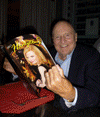Actress, activist, political dynamo, and guru—these are the makings of an icon. Jane Seymour Fonda (or Hanoi Jane to her political critics) has remained on top of her game since the ’60s, having taken Hollywood, politics, the fitness world, and now the publishing community by storm, and she’s still going strong. This stoic beauty shows no signs of settling or slowing down, and has secured her status as a legend for our times.
Jane was born in New York City to screen star Henry Fonda and famed socialite Frances Seymour Brokaw. She was only 12 when her mother committed suicide after voluntarily seeking treatment at a psychiatric hospital. The suicide was kept secret from Jane, who was told that she’d died of heart failure. All newspaper and magazine subscriptions were cancelled, and the staff and students surrounding her were briefed not to discuss it. Fonda learned the truth for herself months later while leafing through a movie magazine that was left out in art class.
As her life slowly moved on, she showed little inclination of stepping out into the limelight, but was prompted to appear alongside her father in the 1954 Omaha Community Theatre production of The Country Girl for charity. But it was not until she began attending Vassar College and was intro-duced to renowned drama teacher Lee Strasberg (subsequently joining his Actors Studio) that Jane’s interest in acting was piqued. She made her screen debut in 1960 with Tall Story, followed by Period of Adjustment and Walk on the Wild Side, in which she had her first role as a prostitute. Jane’s breakthrough role in Cat Ballou began earning her serious accolades (the comedy-Western received five Oscar noms), and a series of comedic roles followed.
Fonda married French film director (and notorious play-boy) Roger Vadim in 1965, and the couple had their first child, daughter Vanessa (named for actress and activist Vanessa Redgrave), in 1968. That same year Jane took the lead role in the sci-fi spoof Barbarella, and her status as a sex symbol was established. Vadim directed the film, and Fonda admits to feeling “pressured” into taking on the risqué role. She confesses in her 2005 autobiography to having participated in threesomes and other sexual explorations during this time at Vadim’s suggestion. “Working in Hollywood does give one a certain expertise in the field of prostitution,” she has said, based, no doubt, on her time with Vadim.
The couple divorced in 1973, and she quickly moved on to marry author and activist Tom Hayden. Between Klute (1971), in which she again played a hooker, and Fun With Dick and Jane (1977), Fonda spent most of the decade without a major film success. Though this did not mean that Jane wasn’t keeping busy—in fact, it was quite the opposite. She gave birth to son Troy Garity (taking his grandmother’s surname for anonymity), and began her espousal of anti-establishment causes and anti-war tirades. Her political activism included the Alcatraz Island occupation (1969), public support for Huey Newton and the Black Panthers, the feminist movement and civil liberties, and her ultra-controversial opposition to the Vietnam War.
"Sitting on an enemy aircraft gun was a betrayal.… It was the largest lapse of judgment that I can even imagine."
In April 1970 she set out with Fred Gardner and Donald Sutherland on the FTA tour (which stood for Free the Army or Fuck the Army), an anti-war road show talking to soldiers about their upcoming deployments. That same year, she organized a rally for the Vietnam Veterans Against the War and started a college campus tour to raise funds for the organization. In 1972 Jane was invited by the North Vietnamese to visit imprisoned American troops in Hanoi, and the events that transpired would not only shock our nation, but threaten Fonda’s hard-won career.
Jane was photographed seated on an anti-aircraft battery used against American aircrews. This image sent shockwaves through viewers back home, and it’s a decision that she regrets to this day. She told CBS News, “Sitting on an enemy aircraft gun was a betrayal.... It was the largest lapse of judgment that I can even imagine.” Her actions were perceived as an unpatriotic display of support for the enemy, with some even calling it treason, and many Americans continue to harbor hostility toward her for it.
After forming the Indochina Peace Campaign, Jane was able to produce films that would help return her star status. During the ’70s, she and Tom also raised a foster daughter, Mary Luana Williams (who was born to members of the Black Panthers), and Jane began taking on roles that focused on important issues. For 1978’s poignant Academy Awards–sweeping Vietnam drama Coming Home, she won Best Actress as the lover of Jon Voight’s bitter paraplegic veteran. She starred in the classics The China Syndrome (co-starring Michael Douglas) and The Electric Horseman (co-starring Robert Redford) in 1979.
By 1980 Fonda was back in a big way, starring in the flick Nine to Five (one of her greatest financial successes) along-side Lily Tomlin and Dolly Parton. The following year she got the opportunity she had long wished for when she worked with her father in the decade-defining On Golden Pond. The two had had a strained relationship for many years, and the emotional film, which closely mirrored their relationship, hit close to home. She said that when making this film she gave so much emotion to the role, but felt that it was unreciprocated personally and professionally. Although there was no cathartic breakthrough for the father and daughter in real life, Jane accepted her ailing father’s Academy Award for Best Actor on his behalf, just five months before his death.
"This is the first time in my life I have owned who I am."
She spent much time with her father during his last few days, sitting bedside at the hospital. She found herself yearning for a much needed closure in their relationship, but instead began a process of introspection. Watching her father’s death made Jane realize that she wasn’t afraid of dying, but rather that she was “terrified of getting to the end of life with regrets.”
A longtime ballet enthusiast, Fonda had taken to aerobics and strengthening exercises in recent years, and ushered in the ’80s with the release of her first exercise video, Jane Fonda’s Workout (1982). The video sold 17 million copies (the most of any home video of all time, and the first major success for the new technology). Jane released 23 more workout videos, five fitness books, and 13 audio tapes. She popularized the phrase “Go for the burn,” and succeeded in encouraging countless women to get into shape. But this venture (like every other) was not without controversy—she was criticized for improving her figure by means of plastic surgery, which included breast implants that took her from a B to a D cup. She has since had her implants removed, and said in a 60 Minutes interview that they made her feel “unwomanly.”
Fonda married her third husband, media mogul Ted Turner, in 1991, and announced her retirement from the film industry that same year. She admits to having been bulimic since the age of 12, but made the decision at 36 to stop “cold turkey.” In an interview with Oprah Winfrey she recalled her breaking point: “I saw myself going down a dark hole, and I had two children, and I was making a difference in the world, and I had to make a choice between the light and the dark. Life and death. And I chose life.” She also chose to become a Christian. After moving to Atlanta (where she still lives), she started spending time with people of faith and people who actually read the Bible; from this, she told Winfrey in Oprah Magazine, she “felt this incredible connection to God, or to what I call the Holy Spirit.”
When Fonda and Turner divorced in 2001, she realized what her final regret in life would be: “if I died and never experienced an intimate relationship.” On the split she says, “Ted needs someone to be there 100 percent of the time. He thinks that’s love. It’s not love. It’s babysitting.” The two remain close friends. “We’ll never be finished. Whatever happens in terms of our living arrangements, we will always be close.”
A lifelong feminist, Jane proceeded with her efforts for women’s rights, determined to make people realize that “feminism is not anti-man.” She established the Jane Fonda Center for Adolescent Reproductive Health at Emory University, and in 2004 led a march with Sally Field and Eve Ensler through Juárez, Mexico, urging Mexican authorities to be more proactive in their investigation of several hundred women murdered near the U.S. border. She is an honorary chairwoman of the off-Broadway hit The Vagina Monologues, and when an all-transsexual cast was used in the show in 2004 (a first for off-Broadway), she served as their mentor.
Though she had claimed to have retired, Jane made a surprising return to the big screen in 2005 (after a 14-year absence) with the box-office smash Monster-in-Law. This came also with the publishing of her intimate autobiography, My Life So Far (Random House). The tell-all describes her life in three acts (each spanning 30 years). In an interview with U.S. News & World Report, she said, “I was approaching 60, and realized this was going to be my last act. I decided that to do my last act properly, I had to understand what the first two acts were about!” The tome is intimate, and holds back nothing about the many regrets and controversies of her personal and public lives. It has won critical praise, and is both reflective and insightful—in true iconic fashion!
Fonda traveled extensively in the U.S. for book-signing events, and still found time to launch a new venture with feminist pal Gloria Steinem called GreenStone Media. The talk-radio network, which debuted this past September, is aimed at women, with intelligent segments on health, raising children, comedy clips, and celeb hosts.
Jane Fonda recently turned 69, and “couldn’t be better.” Empowered, she proclaims, “This is the first time in my life I have owned who I am.” With a lifetime of heady achievements, Fonda is rolling into her next act of life with the same glamour and sophistication that she has upheld throughout her career. Her looks are as timeless as her body of work, and she is truly a woman who has done it all—a real Jane of all trades!
|




